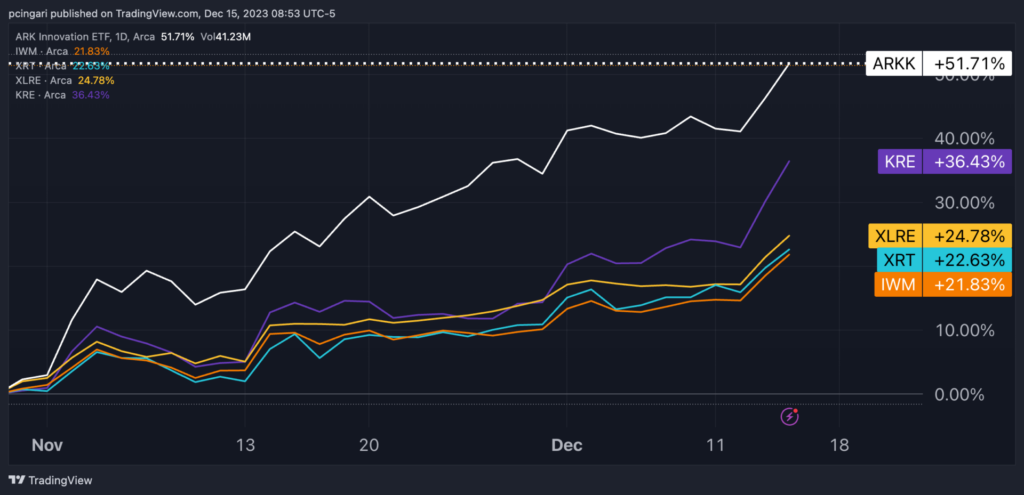Zinger Key Points
- Bank of America predicts 152 global interest rate cuts in 2024, marking a shift towards easing monetary policy.
- Market sentiment leans on the Federal Reserve's potential rate cuts and their impact on various asset classes.
- Feel unsure about the market’s next move? Copy trade alerts from Matt Maley—a Wall Street veteran who consistently finds profits in volatile markets. Claim your 7-day free trial now.
Bank of America chief investment strategist Michael Hartnett, predicts that global central banks will collectively deliver 152 interest rate cuts in 2024. This would mark the first year since 2020 when rate cuts surpass rate hikes.
According to the leading Wall Street analyst, markets are going “all-in” on the “infallible Fed”, already factoring in more than a 150 basis point reduction in interest rates by the U.S. central bank next year.
In December, the Federal Reserve kept interest rates steady at 5.25-5.5% but signaled its willingness to begin reducing interest rates in the coming year. The updated dot plot indicates that the median preference among Fed policymakers is for rates to decrease to 4.6% in 2024, 3.6% in 2025, and 2.9% in 2026.
Investors Flock To Risk Assets
Hartnett notes that the market narrative has shifted from ‘higher-for-longer’ and ‘hard landing’ scenarios to ‘Fed cuts’ and ‘soft landing.’
The analyst points out that the decline in 10-year Treasury yields from 5% to 4% has sparked a remarkable rally in leverage and distress trades.
Since Oct. 31, the iShares Russell 2000 ETF IWM has risen by 21%, the SPDR S&P Retail ETF XRT by 20%, the SPDR Real Estate Select Sector XLRE by 24%, the SPDR Regional Banking ETF KRE by 36%, and Cathie Wood’s ARK Innovation ETF ARKK by 52%.

Read Also: Real Estate, Small-Cap, Gold Miner, Solar Stocks Go Wild On Prospect Of Fed Rate Cuts
Bullish sentiment is evident in investment flows into risk assets in recent weeks.
Over the last seven weeks, investors have poured $1.6 billion into high-yield (HY) bonds, marking the longest streak since September 2020, as noted by BofA.
Global equities have seen the largest eight-week inflow ($74.0 billion) since March 2022, with U.S. equities experiencing their ninth consecutive week of inflows ($25.9 billion), the longest streak since December 2021.
Which Assets Will Rally?
Hartnett has presented various scenarios regarding how major assets might react to Fed cuts and the economic outlook.
If the current consensus is accurate, a combination of Fed cuts, Treasury yields at 4%, and a soft landing of the economy will continue to favor leverage and distressed assets as winners.
If Fed cuts coincide with a hard landing and yields at 3%, U.S. Treasury bonds are likely to outperform.
Hartnett has also outlined a scenario in which there is no landing at all, and the economy continues to exceed expectations, which would benefit commodities as the primary beneficiaries.
However, Bank of America cites a statistic that could temper the enthusiasm surrounding the Fed’s rate cuts.
In the past 90 years, there have been only five occasions when the Fed reduced rates while the core CPI (currently at 4.0%) was higher than the unemployment rate (3.7%). These instances were triggered by either war (October 1942) or recession (October 1969, August 1974, May 1980, July 1981).
Now read: Will Unemployment Spike In 2024? History Of Fed Rate Cuts Would Suggest So
Image: Shutterstock
Edge Rankings
Price Trend
© 2025 Benzinga.com. Benzinga does not provide investment advice. All rights reserved.
Trade confidently with insights and alerts from analyst ratings, free reports and breaking news that affects the stocks you care about.